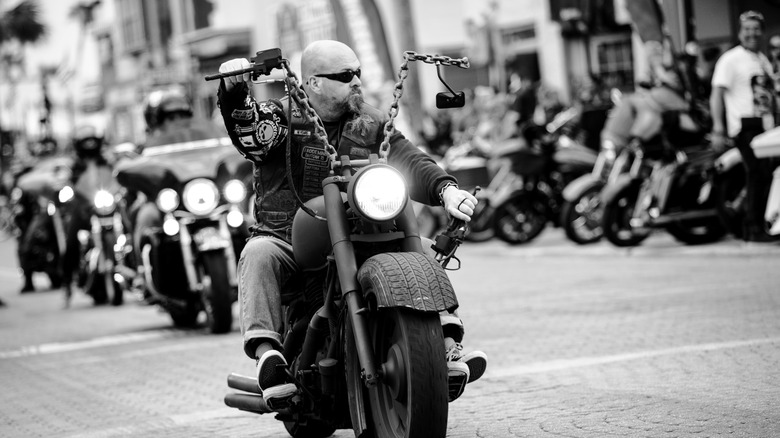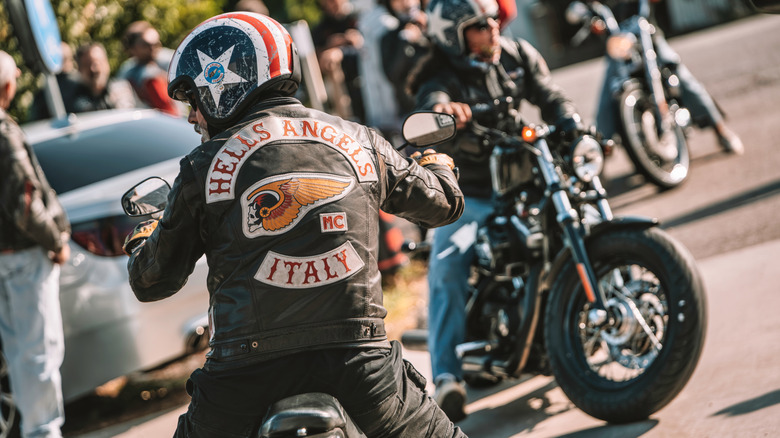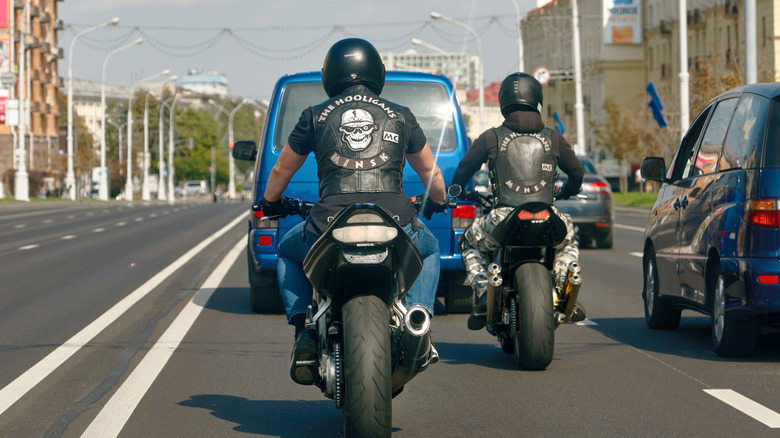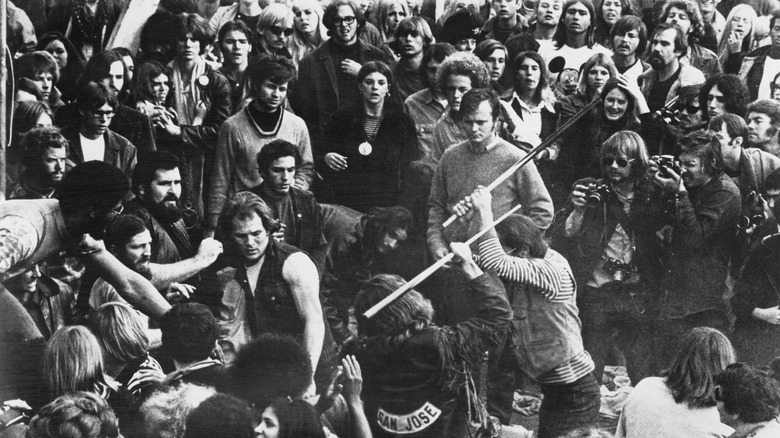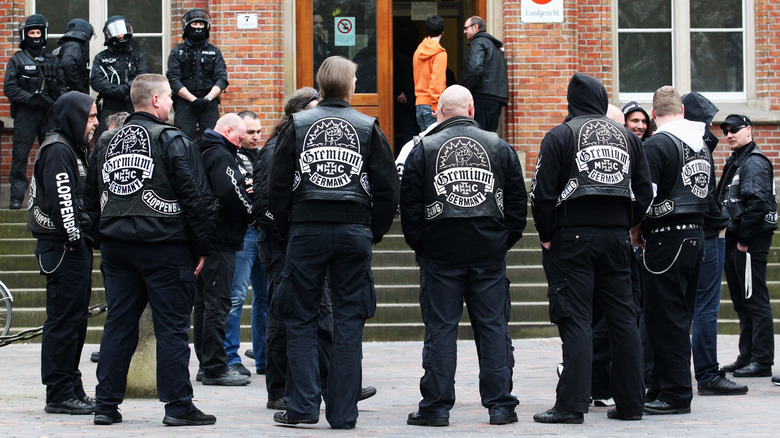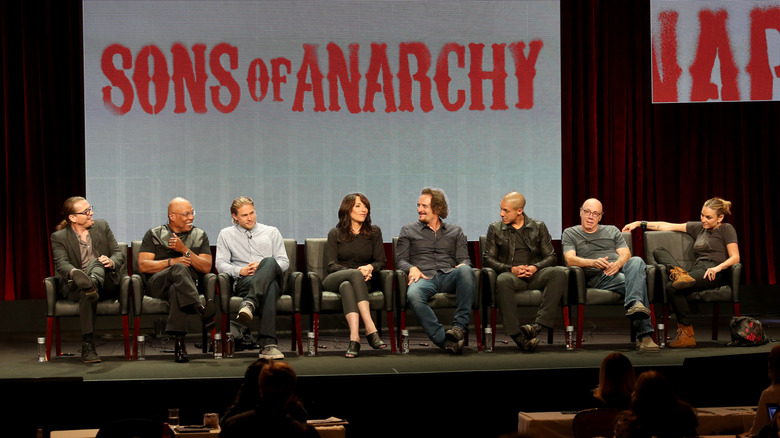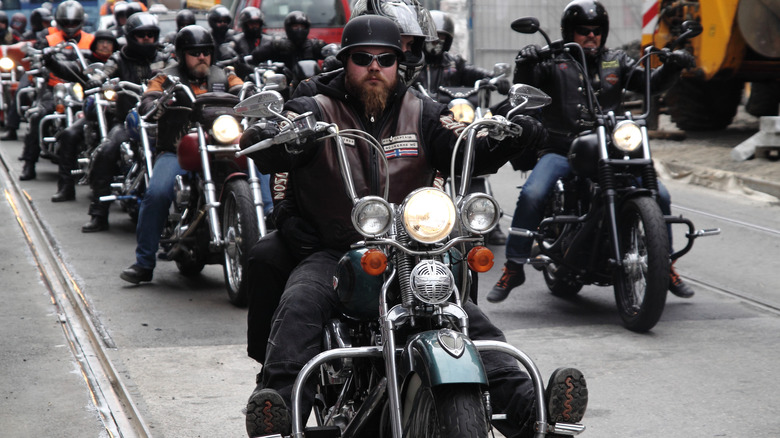American Outlaws: The History Of Biker Gangs Explained
Post-war America came upon a rather unique "issue" in 1945 when the conflict was done. Thousands and thousands of WWII veterans were coming back home; They'd experienced intense camaraderie, constant adrenaline, and a sense of purpose that sorting mail or selling insurance could never bring about. Some of these men found motorcycles. More specifically, they found each other through motorcycles — forming clubs and associations of people who liked to ride. Now, these clubs that were formed weren't initially criminal enterprises, but attempts at recreating the brotherhood that the military had afforded people.
But then, what had begun as groups of vets looking for camaraderie turned (over eight decades) into something a lot more complex. Over time, these clubs became rebellion symbols, then the focus of Hollywood, then threats to public order, and finally, some factions turned to criminality. The DOJ calls some of them "Outlaw Motorcycle Gangs" or OMGs for short — though not every motorcycle club is an OMG. Film mythologized them, law enforcement pursued them, and the media sensationalized them. Each reaction fed the next, creating a feedback loop that attracted both genuine riders and those seeking the outlaw image.
Now, this transition was not fast, nor was it universal; with some clubs remaining focused on riding and brotherhood even today. Other clubs discovered that their layout, structure and loyalty (things that made them good riding clubs) — also made them good at "other pursuits", so to speak. This is how veterans' riding clubs became America's most enduring outlaw subculture.
The Hollister riot of 1947
The sleepy little town of Hollister had always been popular with bikers, because the American Motorcycle Association (AMA for short) would host an annual rally event here. Of course, this event was paused during the war; but two years after the war concluded in 1947, the AMA brought back the Hollister rally.
They named it the "Gypsy Tour" rally, and it was probably meant to be a post-war revival of bike culture in the region. And boy, did people show up. Now, no one can say with surety why the '47 Hollister rally head count exploded like it did; Maybe it was because of the timing — the years of the war cancelling other events — and a new influx of bikers, or some combination of those things.
The fact is that for those three days in the first week of July 1947, the crowd at Hollister became unmanageable. Some sources put the number of people at over 4,000 – which doesn't seem like much when events like the Sturgis rally in 2024 drew a crowd of nearly half a million people. However, consider the fact that Hollister in 1947 only had seven police officers, who were, quite understandably, swiftly overwhelmed. According to reports, people were sleeping in public areas, alcohol bottles were littered everywhere, and of course, the people in the motorbikes were a loud crowd, as expected. The issue was so serious that the state police of California had to be involved to bring things back under control.
The Hells Angels emerge
As you can imagine, the press had a field day with the reporting of the Hollister Gypsy Tour rally. But that didn't deter people from joining — or forming — motorbiking clubs in America; which is precisely why, in 1948, one of said clubs was formed. You may have heard of it — a little outfit who named themselves the "Hells Angels" started their first chapter in Fontana, California. Interestingly, Fontana is just 350 miles or about a four-hour ride away from Hollister. Today, the Hells Angels are considered by the DOJ to be among the "big four" motorcycle gangs in the U.S., though we must stress that not every Hells Angel member is affiliated criminally.
Anyway, from their somewhat modest beginnings in Fontana, the Hells Angels quickly expanded and grew in number, eventually becoming the largest motorcycle club in the world. The group opened new "chapters" — which is their word for branches, in San Francisco and other cities through the '50s, and even expanded internationally in the 60s, when they opened a chapter in New Zealand, of all places. Surprisingly, the club didn't enter Canada until 1977, and even then that expansion was part of a brutal inter-gang war involving the Hells Angels versus the Rock Machine, a Canadian gang who we'll talk about a bit more later. But, alongside their head count, their notoriety was also on the up and up. By the time the 1960s rolled around, many members would find themselves embroiled in criminal activities.
Motorcycle gangs get more criminally involved
As membership to these clubs grew and grew, managing all aspects and coordinating events was probably becoming a headache for the management committees. As a result, they "corporate-ified" their clubs, with many developing organizational structures that were a cross between businesses and the military. For example, clubs would have chapters (branches), chapter presidents, vice-presidents, a sergeant-at-arms, and other such titles. Many also formed their own by-laws, oaths, and constitutions that all members had to abide by. For example, one of the rules every Hells Angel lives by is that no member will speak to the press or to law enforcement about another member or about activities of the club. If needed, only senior members of a chapter like the president would issue a press statement, but this is rare.
Further, any person who has been a member of a law-enforcement outfit is permanently banned from becoming a member of the Hells Angels. Other outfits like the Bandidos have similar rules that all members have to abide by. As readers have probably realized by now, this very organizational structure would also do very well when it came to protecting members from crime. Some of the most prominent sectors — for lack of a better term — that these motorbike gangs were notorious for being involved in were extortion, protection rackets, money laundering, human trafficking, and of course, drug trafficking. Later, the motorbike gangs even began to network with other criminal organizations like prison and street gangs.
The end of 1960s idealism
Towards the end of the 1960s, The Rolling Stones were being belted by the media for having very expensive concert ticket prices. So, the band decided to host a free-to-the-public concert as their tour-ending show. However, after a number of venue changes for various reasons, the concert was finally (and hastily) scheduled to be held at the Altamont racetrack near Tracy, California. One issue that cropped up was security for the concert — and the band's answer was to appoint the Hells Angels as bouncers for the event. That in itself was questionable, but then, the bands made an even weirder one.
Instead of paying the Hells Angels members in cash for providing the event security, they paid them in beer for their service. Now, this ended about as well as one would expect, with many different issues cropping up through the course of the concert. First, there were several cases of car theft, at least one hit-and-run that took the lives of two concert-goers, and various assorted cases of violence. However, the most infamous and widely-reported incident happened when a member of the Hells Angels fatally stabbed an attendee at the event.
Towards the end, the violence was getting so pronounced that The Grateful Dead, who were due to perform before the show-stopping Rolling Stones act, opted to cancel their performance on the day. Later on, the Rolling Stone magazine would call the concert "rock and roll's all-time worst day" in an explanatory piece.
Motorbike gangs expand into Canada
The Altamont concert of 1969 was, in many ways, a precursor to the violence that would follow motorcycle gangs everywhere they went. Nowhere was this clearer than in Canada, where a bloody expansion war occurred in the 1970s though the 1980s.
A local gang called the "Popeyes" was operational in the city of Montreal — but in 1977, they were enveloped within the Hells Angels with little other choice offered to them. This would become a recurring theme, especially with the Angels, who would use its size and influence to threaten other gangs and clubs to join them or to face a takeover. These forced takeovers of other clubs and gangs are known as "patch-over" events, and were plentiful in the expansion phase of the motorcycle gangs. Several Canadian outfits like the Grim Reapers, King's Crew MC, and Lobos MC's from Alberta, Satan's Choice MC from Ontario, and the Rebel's MC from Saskatchewan, all patched over to American outfits like the Hells Angels, Bandidos, and Outlaws.
It's worth noting that during a patch-over, the club that is being "absorbed" will hang up and abandon its colors, logos, motto, and essentially, identity. Its members will take on the colors and ethos of the new parent club. These patch-over events all helped American motorcycle gangs expand into Canadian territory, with some reports alleging that the motivation to do so was to control lucrative criminal activities in the country.
Colors, patches and tattoos
Now that we've covered patch-over events, we should also talk about the patches themselves. Each major biker gang will have its own signature color or color combination. This is the first big distinction. They will also have an assortment of patches for different roles, seniorities, and achievements that will be given to members for various reasons. These members often sew these patches onto their riding jackets and sometimes trousers that they don when out for a ride, as a way to indicate to the public and other riders that they are a part of a particular club or faction.
Interestingly, while resignations from a biker gang are rare, if a member does opt to leave the "brotherhood" — as many gangs refer to themselves — they are almost unilaterally required to submit all patches and clothing items related to the gang. Now, these colors and patches are all quite distinctive in their own right, visible from a fair distance away.
For instance, the Hells Angels colors are red and white, the Outlaws MC designates its members with black and white, the Vagos MC uses green, and the Bandidos, who are the largest motorcycle club in Texas, uses red and gold as its choice of hue. Many members also have tattoos specific to the gang that they have joined, that would need to be removed before resigning. This trend got so popular that when people picture members of bike gangs now, they most often picture a tattooed-up individual clad in full leather riding gear.
The gangs begin to franchise
Many of these gangs had begun to form affiliations and even alliances with other criminally-inclined enterprises, such as old-fashioned street gangs. However, that expansion couldn't hold a candle to the time period when these motorcycle gangs began to increase their members and chapters. During the 1980s and 1990s, virtually every single major gang began to aggressively open new branches in hitherto untapped locations, and as such, their number of affiliated members began to grow.
Also, those patch-over events that we talked about earlier would further increase the head count. With every new location opening, the opportunities for crime increased — but so did competition. For instance, a notorious time period was when the Hells Angels made a push for dominance in Canada during the 1990s.
A rival gang called the Rock Machine was king of the hill in Montreal, Canada; and the Angels were having none of that. This led to one of the bloodiest takeovers in the country, with some estimates putting the number of fatalities at over 150 — many of whom were innocent bystanders. The number of locations that these biker gangs now have is mind-boggling, with the Angels having 469 chapters, the Bandidos with 303, and the Mongols Motorcycle Club also present in many countries, for its part. As things stand at the time of writing, the "big four" motorcycle gangs have an estimated head count of 6,000 (Hells Angels), 2,000 (Mongols MC), and 1,500 (Bandidos).
Rivalries and alliances begin to strengthen
Back to the 90s. During this period of expansion of the gangs, territorial wars were almost everywhere. An ongoing feud between the Mongols and the Hells Angels was revitalized after a massive brawl between the Angels and the Mongols at an event. This, and other events like the 90s Rock Machine takeover, only served to deepen the rifts that were forming between the outlaw groups. However, the flip side was also holding true, with respective alliances also strengthening to a fair degree. For instance, the Outlaws MC, one of the "big four" gangs, is allied with the Bandidos, and its rivals include the HAMC — an acronym for the Hells Angels Motorcycle Club.
Another alliance that holds strong even today is that of the HAMC and the Sons of Silence MC. Furthermore, the Sons of Silence group is an active rival of the Outlaws group, so the SoS MC and the HAMC are effectively double-allies in that regard. While specific examples would be too lengthy to go through, many other examples exist in this dark and twisted world.
But these rivalries and alliances don't end with territorial and turf wars. They also encompass economic activities of the gangs — and you guessed it, that includes criminal activities. By some estimates, motorcycle gangs were said to control up to 80% of the PCP (methamphetamine) market in New York. The same probably held true for other states, though maybe not to that extent.
Hollywood popularizes the biker
Biker gangs rose to prominence once again (just like they had in the past) thanks to Hollywood. Yes, several mainstream media shows and movies depicted the biker as a rebel, someone who refused to conform to societal ideals, and of a person who dared to break the mold, so to speak. In the series, "Sons of Anarchy" that ran from 2008 to 2014, the biker was painted as free, rugged, and dangerously independent. At the same time, sensationalist media coverage would also paint bikers in the wrong light – which attracted a certain kind of individual, mainly the thrill-seeker and the criminal opportunist, to the club-slash-gang in the first place.
This would go on to create a sort of "feedback loop", where people seeking thrills and criminality would actively look to join a biker gang and carry out their activities; and by doing so; increase the coverage that these gangs would get for those activities. The cycle would continue and was well-documented even in the past, with flicks like "The Wild One" (1953) and "Easy Rider" (1969) — but that didn't stop it from happening again. A key offshoot of this time in the limelight on the big screens around the world was that it brought the issue of biker gangs back into the public eye. The issue of biker gangs was no longer something that could be swept under the rug, not least because prime-time telly kept running shows about it.
Government intervention
All this notoriety and being brought into the public eye would result in intervention by the government, and that's exactly what happened. A crackdown of epic proportions came about at the turn of the century on both sides of the border. A key development right about now was the use of the RICO act — short for Racketeer Influenced and Corrupt Organizations — to prosecute the motorcycle gangs. Crucially, this would no longer stop at prosecuting individual acts of violence or crime, but would treat the entire gang as a criminal organization to be dealt with.
As a result, the Department of Justice, and several three-letter agencies in the U.S. like the FBI, DEA, ICE, and ATF stepped up their investigations and prosecutions of these outlaw biker gangs. Through the 2010s, many different high-profile convictions and arrests came about, such as the 41-person Devils Disciples arrests in 2012. We would argue that the crackdown is still going at full tilt, with major arrests and indictments being announced every couple months, it feels like. For instance, the latest major news in this regard was two dozen people being arrested in Florida as part of a larger biker gang crackdown earlier in 2025.
There was also an indictment for the Bandidos operating in the Houstin, Texas area on several felony charges just a week before the Florida arrests in February 2025. When all's said and done, this is a welcome move.
Biker gangs in the modern day
Eight decades on, the American outlaw biker is less about crime and more about cultural endurance. However, several members do remain heavily involved in illicit activities. Clubs like Hells Angels, Outlaws, and Mongols maintain heritage and hierarchy, yet face fragmentation, legal bans, and generational drift. But at the same time, some gangs will likely evolve and move into new markets.
Who knows? Perhaps the days of motorcycle gangs are over, and only riding clubs will survive — which is definitely a desirable outcome. Outlaw motorcycle gangs have indeed had their heyday; They took the world by storm and, for better or worse, captured the public fancy. It's a tough act to follow, and with crackdowns around the world, we don't know if they'll survive. Across the world, governments classify them as organized crime threats, while pop culture still sells their legend in leather and chrome. In the end, the outlaw biker's legacy is a cautionary tale of rebellion consumed by its own violence.
